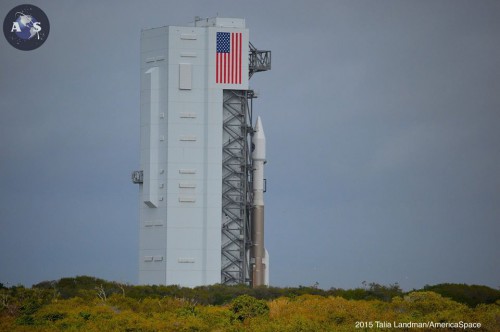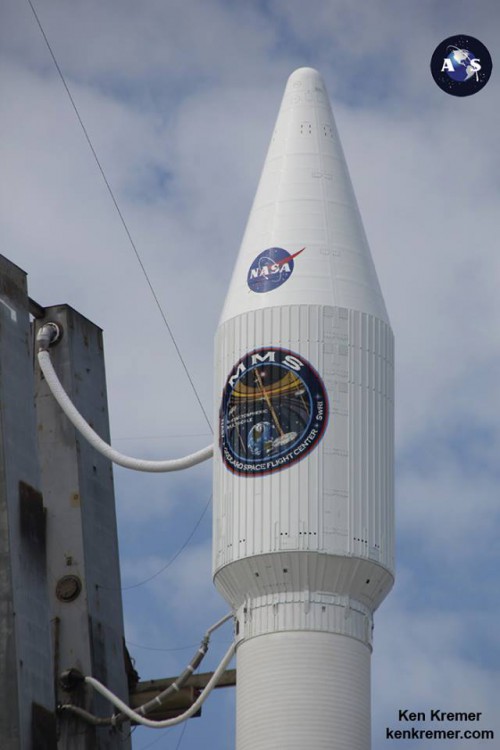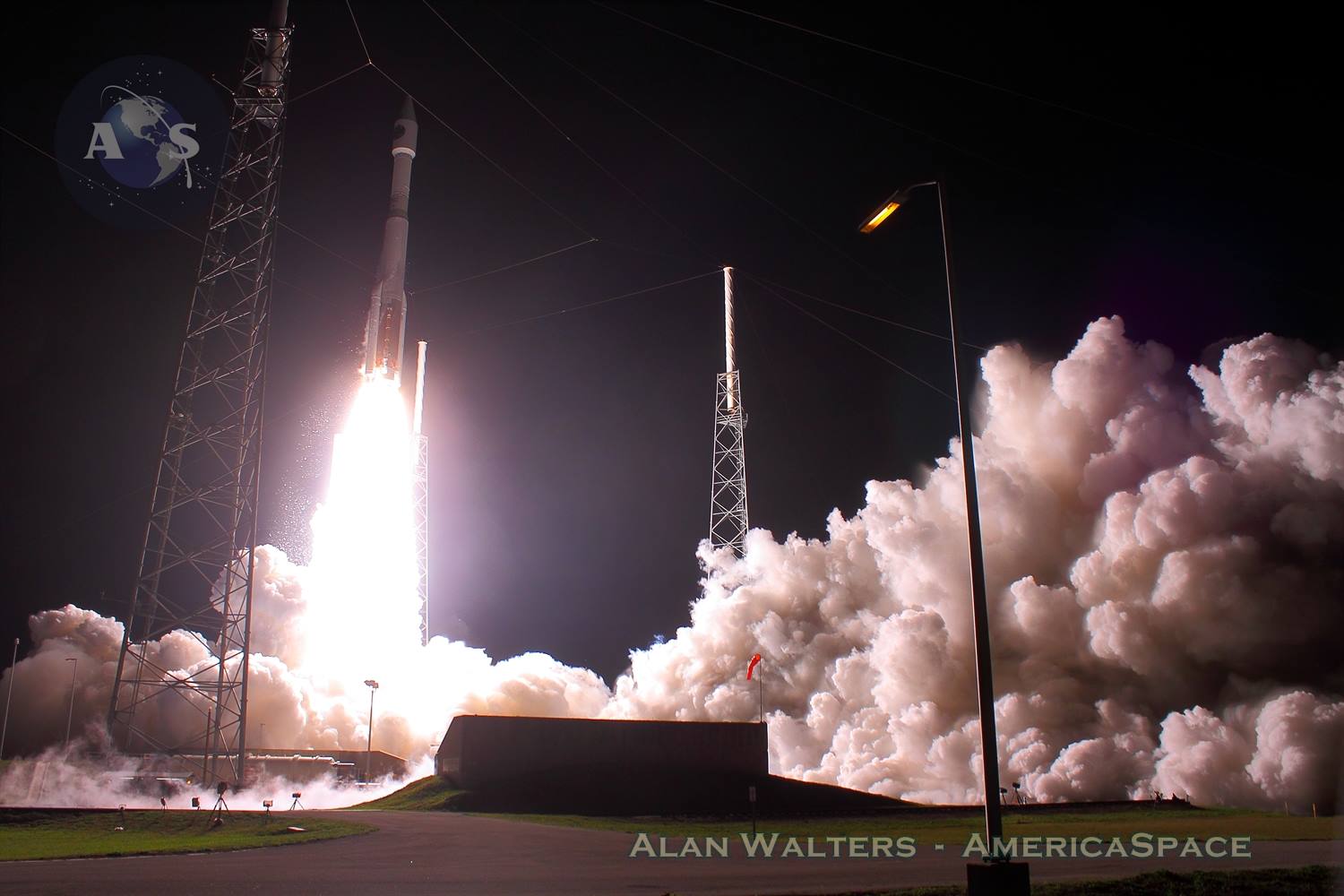United Launch Alliance (ULA) has successfully flown its highly reliable Atlas V booster out of Cape Canaveral Air Force Station, Fla., to deliver the four-spacecraft flotilla of NASA’s Magnetospheric Multiscale Mission (MMS) into a Highly Elliptical Orbit (HEO) to explore the microphysics of “magnetic reconnection,” a process which converts magnetic energy into heat and kinetic energy and which carries profound lessons for the “space weather” in Earth’s neighborhood. Liftoff of ULA’s Atlas V—which was flying for only the fourth occasion in its “421” configuration, equipped with a 13-foot-diameter (4-meter) payload fairing, two strap-on solid-fueled rockets, and a single-engine Centaur upper stage—took place from the Cape’s storied Space Launch Complex (SLC)-41 at 10:44 p.m. EDT Thursday, 12 March, right on the opening of the 30-minute “window.”
The vehicle commenced formal processing last month, when the Common Core Booster (CCB) of the Atlas V was mounted atop the Mobile Launch Platform (MLP) at SLC-41. Its twin strap-on rockets—manufactured by Aerojet Rocketdyne—were attached to the stack on 7-9 February, followed by the interstage and the Centaur a couple of days later. As described by AmericaSpace’s Talia Landman, the MMS payload was transferred to the pad on 27 February and, ensconced within its Extra-Extended Payload Fairing (XEPF), was mated to the Centaur shortly afterwards. This was followed by the joint NASA-ULA Flight Readiness Review (FRR) on Friday, 6 March, and a Countdown Dress Rehearsal and Launch Readiness Review (LRR) on Monday and Tuesday of this week. Passing through each of these milestones without incident, the Atlas V 421 vehicle was transferred atop the MLP from the Vertical Integration Facility (VIF) to the SLC-41 pad surface on Wednesday.

Weather conditions for Thursday night’s opening launch attempt were predicted to be around 70 percent favorable, according to the 45th Space Wing at Patrick Air Force Base. Rollout of the Atlas V to the pad was accompanied by a “warm, moist southerly flow” expected to “increase moisture, resulting in an isolated shower threat,” coupled with a “small threat” of a thunderstorm in the late morning and early afternoon. On Thursday, a stationary front was “expected to remain in North Florida/South Georgia with a developing low-pressure system in the Central Gulf of Mexico,” it was noted. “Upper-level moisture over Central Florida from this system increases through the evening hours. Likewise, south-easterly winds deepen and strengthen by the evening, increasing the coastal shower threat.” Overall, Thursday afternoon was expected to remain “partly cloudy,” with a 30 percent probability of rain. That said, the core concerns for a successful launch on Thursday remained Cumulus Clouds and Thick Clouds, with the same conditions expected to worsen to just 60 percent favorable in the event of a 24-hour scrub to Friday evening.
Notwithstanding the meteorological outlook, ULA teams pressed ahead with readying the hardware for the 53rd flight of an Atlas V since the vehicle’s maiden voyage, way back in August 2002. With the exception of its 10th flight in June 2007—which succumbed to a premature shutdown of its Centaur, caused by a leaking fuel valve, and dumped a pair of Naval Ocean Surveillance System (NOSS) satellites into a lower than intended orbit—the Atlas V has an unblemished record and is one of the most reliable boosters in active operational service.
Formal countdown operations got underway Thursday afternoon at T-6 hours and 20 minutes, with the activation of flight control systems. By this stage, weather conditions had improved to 80 percent favorable. Ground Command Systems testing occupied about 3.5 hours, as engineers verified communications between the Atlas V and the Launch Control Center (LCC), ahead of the process to load liquid oxygen and a highly refined form of rocket-grade kerosene (known as “RP-1”) aboard the CCB. Since the former undergoes cryogenic “boil-off” and must be continuously replenished until close to T-0, it was loaded relatively late in the countdown, whereas the RP-1 experiences no leakage or reduction in capacity and consequently had already been pumped aboard the Atlas. Following a built-in hold, authorization was granted at shortly after 8 p.m. to commence liquid oxygen tanking.

The loading of cryogenic oxidizer into the CCB and the Centaur passed smoothly through Slow Fill and Fast Fill loading modes, before finally transitioning to “Topping,” in order to continuously replenish the effects of boil-off. Shortly thereafter, liquid hydrogen was fully loaded aboard the Centaur by 9:38 p.m. Cycling tests of the fill-and-drain valves on both the Atlas V and the Centaur were successfully accomplished. With all tanks confirmed at Flight Level, the final checkout of the Flight Termination System (FTS)—which was tasked with destroying the Atlas in the event of a major accident during launch—was performed and the ascent software was updated. The countdown entered its final, 30-minute built-in hold at T-4 minutes at 10:10 p.m., during which time the ULA Launch Conductor took the opportunity to perform last checks of the vehicle, the MMS payload, and the unfolding weather situation. The four MMS spacecraft were placed onto internal power, running off their on-board batteries until such time as they achieved orbit and could begin to utilize their electricity-generating solar arrays.
It remained a beautiful night, with weather conditions holding steady at 80 percent favorable. “Throughout the countdown today, there have been a number of weather balloons launched to monitor conditions that the rocket will have to fly through,” noted AmericaSpace’s Launch Tracker. “In particular, the upper-level winds have been examined and the flight computer has now been programmed to enable it to fly in the prevailing conditions.” A final “Go/No-Go” poll of all stations emerged with a unanimous “Go” from across the board at 10:38:16 p.m. to proceed with tonight’s opening launch attempt, and at 10:40 p.m. the countdown clock was released from its hold point at T-4 minutes. During this phase the FTS was armed, and at T-60 seconds the Launch Control System was enabled, the topping-off of propellants ended, and the rocket’s on-board systems assumed primary command of all critical functions through liftoff.
“Range Green!” came the call from the Range Operations Co-ordinator (ROC).
Liftoff got underway at T-2.7 seconds, with the ignition of the Atlas’ Russian-built RD-180 first-stage engine, which burns liquid oxygen and RP-1 and generates 860,000 pounds (390,000 kg) of propulsive yield. The two solid-fueled boosters, each measuring 67 feet (20.4 meters) tall, also ignited and produced a combined thrust of almost 700,000 pounds (316,000 kg) to supplement the boost away from SLC-41. Climb-out of the 195-feet-tall (59.4-meter) Atlas V 421 commenced at T+1.1 seconds, beginning an apparently slow ascent to about 85 feet (25.9 meters), after which the avionics of the Centaur upper stage commanded a pitch, roll, and yaw program maneuver to establish the vehicle onto the proper flight azimuth of 99.0 degrees, in order to deliver the quartet of MMS spacecraft into orbit.
Sixty-two seconds into the flight, the Atlas V passed through a period of maximum aerodynamic turbulence, colloquially known as “Max Q,” and throttled down its RD-180 engine and began a nominal zero-pitch and zero-yaw angle of attack to minimize these loads. At T+138.6 seconds, the two strap-on boosters, now exhausted of their fuel, were jettisoned, and the RD-180 continued to burn hot and hard for another two minutes. When the vehicle reached a peak load of 4.6 G, the RD-180 was throttled back to maintain this level.

Booster Engine Cutoff (BECO) occurred at T+249.7 seconds and was followed, six seconds later, by the separation of the 41.5-feet-long (12.6-meter) Centaur and the attached MMS payload from the spent first stage. To support the delivery of the four satellites into their correct orbital “slot,” the Centaur executed two lengthy firings of its 22,300-pound-thrust (10,100 kg) RL-10A engine. The initial burn got underway at T+265.7 seconds and ran for more than nine minutes, terminating at about 13.5 minutes into the mission. A few seconds after the burn began, the two-piece (or “bisector”) Extra Extended Payload Fairing (XEPF)—which, at 45.9 feet (14 meters) long, is the largest of three 13-foot-diameter (4-meter) payload fairing types utilized by the Atlas V—was discarded.
After the conclusion of the first Centaur burn at 10:57 p.m. EDT, the stack drifted for almost an hour, before the second burn kicked off 11:56 p.m., about 72 minutes after launch. By this time, the stack was flying high above the Pacific Ocean, to the north-east of Australia. This firing ran for six minutes, with the RL-10A shutting down and falling silent for the last time at T+78 minutes and 11.3 seconds. The stage was thus set to deploy the four-strong MMS stack into a Highly Elliptical Orbit (HEO) with an apogee of about 43,600 miles (70,165 km) and a perigee of 364 miles (585 km), inclined 28.77 degrees to the equator, with each spacecraft departing the Centaur at five-minute intervals from about 92 minutes to about 107 minutes after launch. According to AmericaSpace’s Launch Tracker, their deployment times occurred, respectively, to the west of the Baja Peninsula, over the southern states of the continental U.S., and approaching the Gulf of Mexico.
The highly elliptical orbital path will send the MMS flotilla “upstream” toward the Sun, then “downstream” away from the Sun, in order to better study the processes of the magnetic reconnection phenomenon. As described by AmericaSpace’s Talia Landman in her in-depth overview of the science aspects of MMS, magnetic reconnection plays an important role in our planet’s well-being, as well as the health of our space-based assets and our everyday lives. “Magnetic reconnection begins with solar flares and Coronal Mass Ejections (CMEs) on the Sun,” she wrote. “The energy from these explosions interferes with Earth’s protective bubble, the magnetosphere, and causes disruptive space weather. When this happens, it affects Global Positioning System (GPS) signals, spacecraft electronics and radio communications and causes communications blackouts on Earth. On the flip side, magnetic reconnection can be very beautiful, producing an elegant light show in the Northern and Southern Hemispheres, known as the Aurora Borealis (north) and Aurora Australis (South).”

The MMS mission has been more than a decade in the making. First outlined in a NASA Announcement of Opportunity in the fall of 2002, two proposals were submitted in March of the following year and both were selected the following September to conduct a six-month implementation-feasibility study. At length, in May 2005, a team led by the Southwest Research Institute (SwRI) of San Antonio, Texas, was chosen to develop the $140 million suite of scientific instruments for MMS. A year later, in May 2006, NASA’s Goddard Space Flight Center of Greenbelt, Md., was selected to manage the design and development of the four identical spacecraft. By mid-2012, integration of the 25 sensors for the scientific instrument “decks” for the four spacecraft had gotten underway. “This is the first time NASA has ever built four satellites, near-simultaneously, like this,” said NASA-Goddard’s MMS Project Manager, Craig Tooley. “It feels like we’re planning a giant game of musical chairs to produce multiple copies of a spacecraft. One instrument deck might be two-third finished, while another one is one-third finished, and the same people will have to test a nearly complete deck one day and install large components on another one another day.” In late August 2012, the mission passed its Systems Integration Review (SIR), which paved the way for the scientific instruments to be installed, and by the end of May 2013 the fourth and final spacecraft had been fully integrated.
Each of the four octagonal spacecraft weighs about 2,750 pounds (1,250 kg) and measures about 4 feet (1.2 meters) tall and about 12 feet (3.6 meters) in diameter. Each carries four 200-feet-long (60-meter) wire booms in the spin plane and two 41-feet-long (12.5-meter) booms in the axial plane for its electric field sensors, as well as a pair of 16-feet-long (5-meter) spin-plane booms for its magnetometers. A monopropellant attitude-control system will utilize 12 thrusters to achieve small-formation maintenance—keeping the spacecraft within plus or minus 0.5 degrees of the desired orientation during science operations—and larger apogee-raising maneuvers, whilst electrical power will be provided by eight body-mounted solar panels on each of the spacecraft’s faces.
In addition to its role in the environmental testing of the spacecraft, as well as supporting integration with the Atlas V and the development of the MMS Mission Operations Center, NASA-Goddard also built the Fast Plasma Investigation (FPI) research instrument. Tasked with operating 100 times faster than any previous similar instrument, the FPI will collect a full-sky map of data at the rate of 30 times per second, measuring plasma concentrations with four dual electron and four dual ion spectrometers to create three-dimensional images of the plasma and capture as much detail as possible during its second-long journey through the magnetic reconnection “site.” In addition to the FPI, each spacecraft carries instrumentation for the analysis of hot plasma composition and fields and energetic particles.
Want to keep up-to-date with all things space? Be sure to “Like” AmericaSpace on Facebook and follow us on Twitter: @AmericaSpace
Missions » MMS »




